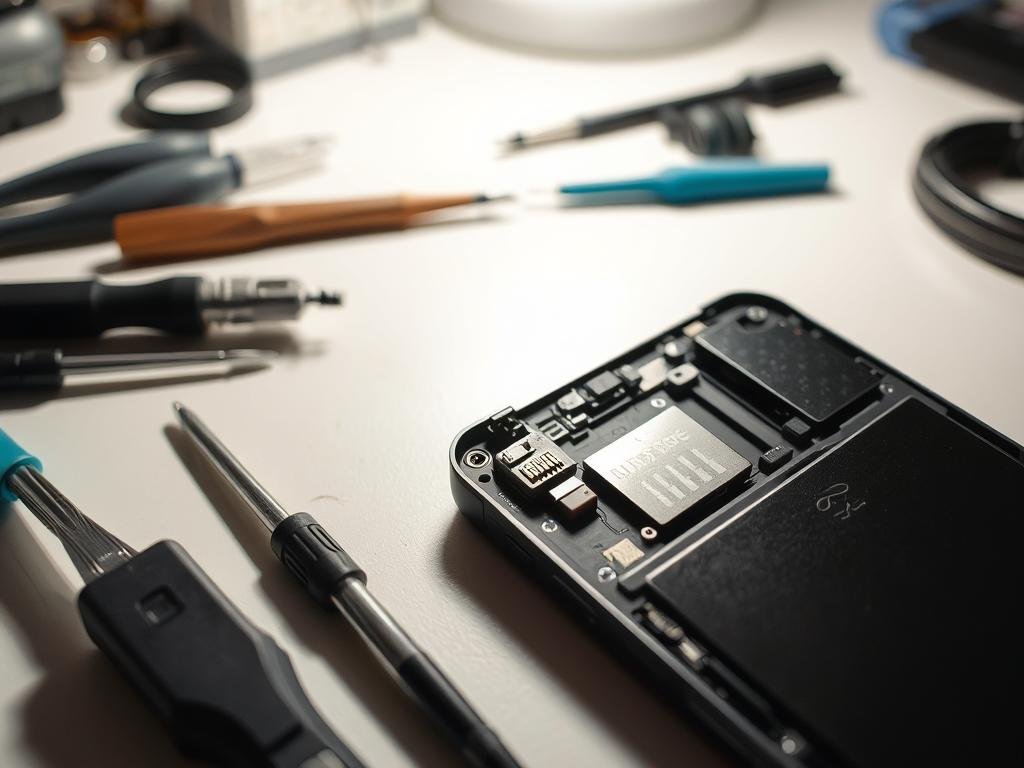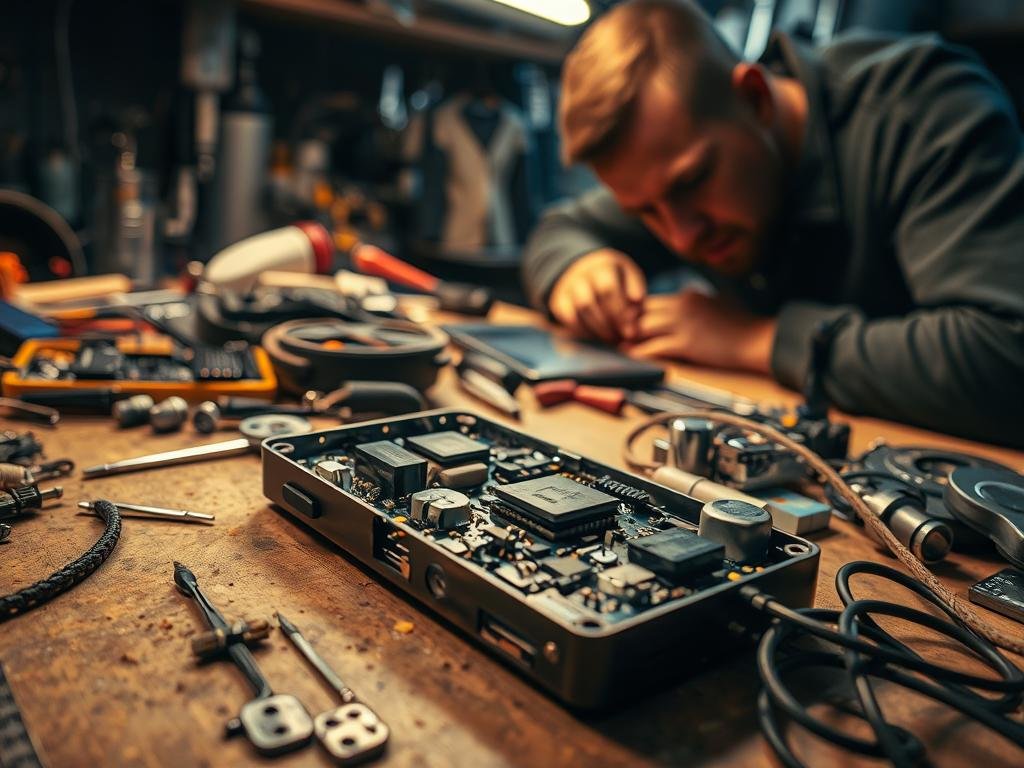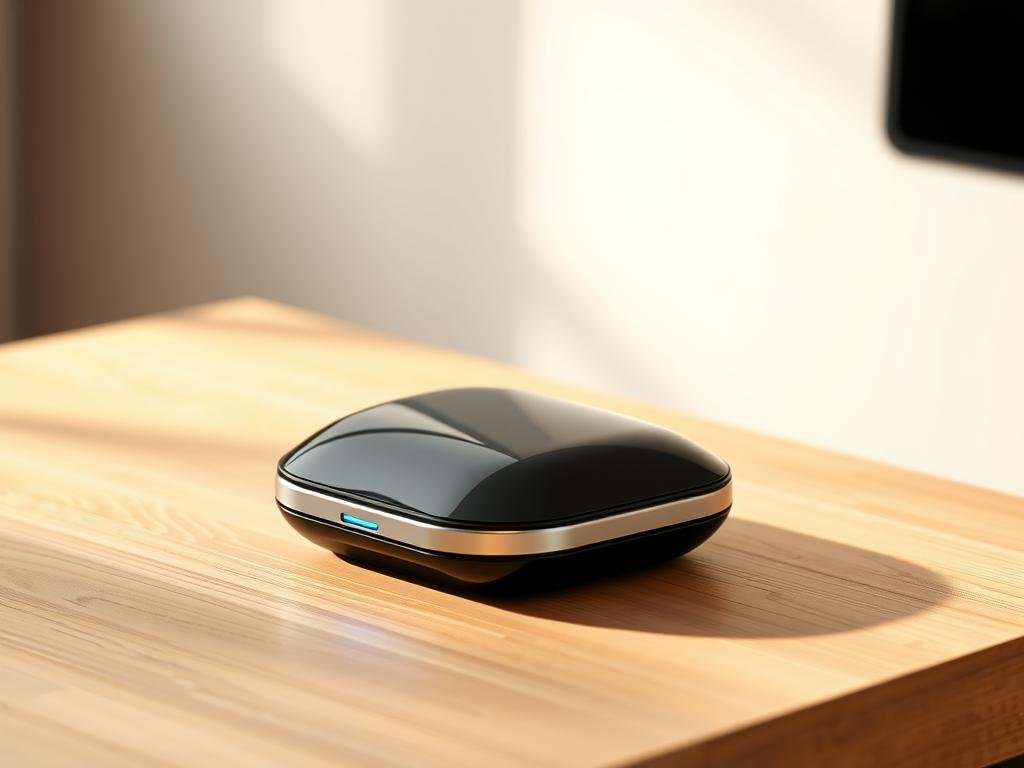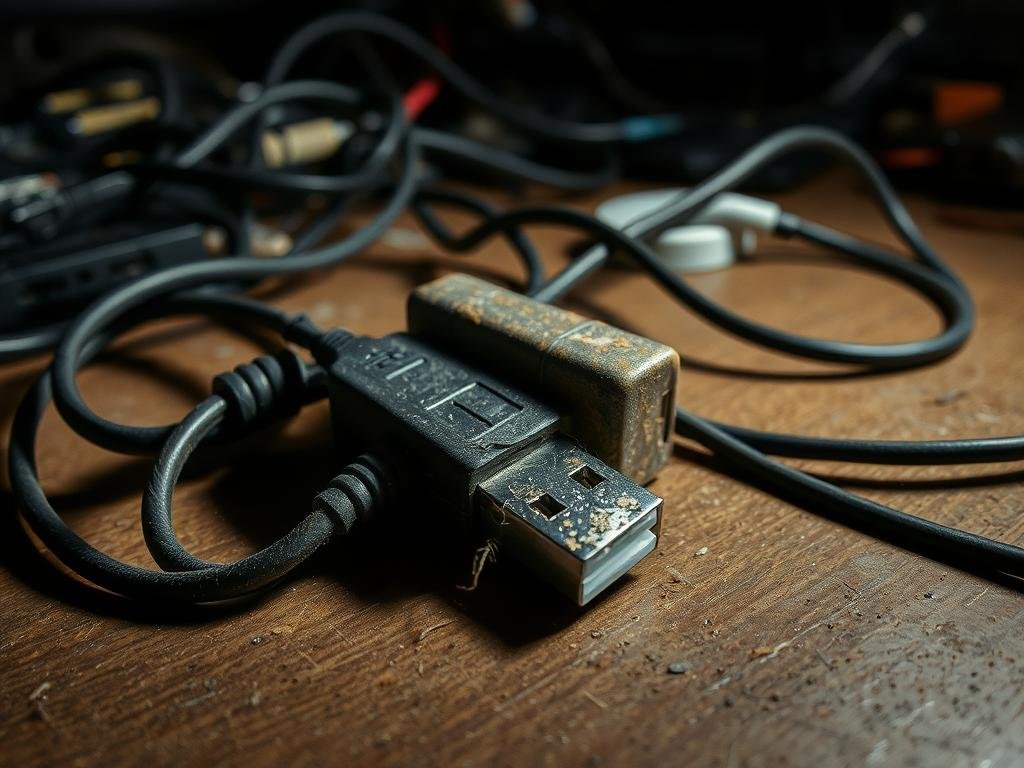Charger Broken. A faulty charger can really mess up your day. It stops you from charging your phone, laptop, or tablet. This can really slow you down.
But, you don’t have to be an electrician to fix it. Just a few simple checks can help you find and fix the problem. For example, using a bad charging cable can cause your phone to overheat. Make sure to use the right charging accessories to avoid this.
Key Takeaways
- Identify common issues with your charger
- Learn simple fixes for charger problems
- Understand the importance of using certified charging accessories
- Discover how to prevent overheating issues related to charging
- Apply quick fixes to get your devices charging again
Identifying Signs of a Broken Charger
Chargers can fail for many reasons. It’s important to know how to spot these problems for quick fixes. If your charger isn’t working right, it might be the charger, the wall socket, or your device’s charging port.
Common Symptoms of Charger Failure
There are several signs that show a charger is failing or has failed. These include:
- A loose connection or fraying in the charging cable
- The charger not fitting snugly into your device’s charging port
- Overheating during use
- Your device not charging at all, or charging intermittently
If you see any of these signs, your charger might be the problem. Troubleshooting means checking the charger and its parts for damage or wear.
How to Test Your Charger
To see if your charger works, try these steps:
- Use the charger with a different device to see if it charges
- Test a different charger with your device to rule out issues with the device’s charging port
- Inspect the charging cable for any signs of damage
These simple tests can help you figure out if the charger is the issue. If you’re not sure, it’s a good idea to get professional help.
When to Seek Professional Help
If you’ve tried troubleshooting and your charger is not working, it’s time to seek help. Experts can find problems that aren’t easy to spot, like internal damage to the charger or issues with your device’s charging circuitry.
Trying to fix complex problems yourself can cause more damage. Instead, talk to a technician who can give a proper diagnosis and suggest the right repairs or replacements.
Understanding Different Charger Types
Chargers come in many types, making it hard to choose the right one. Each charger is made for specific needs and devices. Knowing the differences is key to fixing and using them right.
USB vs. Micro USB vs. USB-C
USB, Micro USB, and USB-C are the most common chargers. USB is a standard connector for charging and data transfer. Micro USB is smaller, found in older phones. USB-C is the newest, with faster speeds and easy plug-in.
| Charger Type | Speed | Reversibility |
|---|---|---|
| USB | Standard | No |
| Micro USB | Standard | No |
| USB-C | Fast | Yes |
Wall Chargers vs. Car Chargers
Chargers differ in where you plug them in. Wall chargers plug into outlets, great for home or office. Car chargers use a vehicle’s socket for charging on the move.
- Wall chargers are perfect for charging at home.
- Car chargers are great for charging while driving.
Wireless Chargers: Pros and Cons
Wireless chargers charge without cables, using electromagnetic fields. They’re easy to use and don’t wear out charging ports. But, they charge slower than wired chargers.
Knowing about charger types is important for charger repair and keeping your devices working. Whether fixing a broken phone charger or looking to upgrade, understanding your options saves time and hassle.
DIY Fixes for Common Charger Issues
Fixing your charger might be easier than you think with these DIY tips. Often, charger problems can be solved with simple steps. This saves you the hassle and cost of buying a new one.

Cleaning the Connector
Dirty or clogged connectors are common charger issues. Dust, lint, and debris can block connections. To clean, use a soft brush or cotton swab to remove debris.
For tough dirt, dampen the cotton swab with water. But, dry the connector well afterward.
Checking for Fraying or Damage
Look for fraying or damage on your charging cable. A damaged cable can stop your device from charging. If you find damage, consider replacing the cable.
Regularly check your cables to catch problems early.
For more detailed guidance on troubleshooting charging issues, you can visit this resource for additional tips.
Replacing the Charging Cable
The charging cable often causes charger failure. If your device won’t charge, try a different cable. If it works, the original cable was faulty.
When replacing, choose a high-quality cable that fits your device. A good cable ensures reliable charging and keeps your battery healthy.
By following these DIY fixes, you can often solve common charger problems without buying a new one. Regular maintenance, like cleaning connectors and checking cables, also helps your charger last longer.
When Your Charger Gets Hot
When your charger overheats, it’s a sign something’s wrong. Overheating can harm your charger and is a safety risk.
Is Overheating a Safety Concern?
Yes, overheating is a big safety issue. It can shorten your charger’s life and even cause fires. If your charger is hot, fix it fast.
Overheating chargers can lead to:
- Damage to the charger’s parts
- Higher risk of electrical fires
- Harm to the device being charged
Tips for Preventing Overheating
To avoid overheating, use your charger right and keep it clean. Here’s how to keep it cool:
- Use your charger in a well-ventilated area.
- Don’t cover your charger or put it under things that trap heat.
- Don’t charge too many devices at once.
- Check your charger for wear or damage often.
For more info on why your charger might be hot, check this resource.
When to Stop Using a Heated Charger
If your charger keeps getting hot, stop using it. Using a hot charger can cause serious problems, like fires. If it’s old or damaged, get a new one.
Signs it’s time for a new charger include:
- Visible damage or wear
- Often overheating
- Slow charging
Getting a new charger can solve these problems. Make sure it fits your device and is high quality. This ensures safe and efficient charging.
Troubleshooting Your Device’s Charging Port
If your device won’t charge, check the charging port first. This part is used a lot and can get damaged easily.
Inspecting for Debris and Dust
Debris and dust can block your device’s charging port. Things like lint or small objects can get stuck. Look at the port with a flashlight or your eyes.
Cleaning the port might fix the problem. Use a soft brush or compressed air to remove dust. But be careful not to push dirt deeper.

Testing with a Different Charger
If cleaning doesn’t help, try testing your device with a different charger. This will show if the charger or device is the problem. If it charges with another charger, the issue is with the first one.
Knowing When to Clean the Port
Keeping your charging port clean can stop problems. If your device charges sometimes or not at all, clean it. Also, clean it if you’ve used it in dusty places or see debris.
“Regular cleaning of your device’s charging port can significantly reduce charging issues.”
By trying these steps, you can often fix charging problems with your device’s port.
How to Extend the Life of Your Charger
To make your charger last longer, take good care of it and use it wisely. A few easy steps can keep your charger working well for a long time.
Proper Storage Techniques
Storing your charger right is a big help. Don’t wrap the cable too tight around the charger. This can hurt the wires inside. Keep the charger and cable in a cool, dry spot, away from sunlight. A cable organizer can also keep the cable from getting tangled or damaged.
Tip: Use a protective case or pouch for your charger when you’re not using it. It keeps it safe from dust and damage.
Avoiding Common Mistakes
Many people unknowingly harm their chargers. Overcharging your portable charger is a big no-no. It shortens the battery life and can damage the charger. Also, don’t bend or twist the cable too much. This can cause it to fray or break.

Using your charger in harsh places is another mistake. Extreme temperatures, moisture, and chemicals can all hurt your charger.
Choosing Quality Accessories
The quality of your charger and accessories matters a lot. Choose chargers and cables from trusted brands. They ensure you get a product that’s safe and meets quality standards. Cheaper options might look good but can be lower quality and even dangerous.
Investing in a high-quality charger makes charging better and helps your device’s battery last longer.
By following these tips, you can make your charger last longer. Regular care and smart use are key to keeping your charging accessories in top shape.
Understanding Charging Speeds
Slow charging can be frustrating. But, knowing how charging speeds work can make a big difference. The speed depends on the charger, cable quality, and if your device can use it.
What Affects Charging Speed?
Several things can change how fast your device charges. These include:
- The charger’s power output
- The quality and type of charging cable
- Device battery health
- Charging port cleanliness
For example, a good USB-C charger can make charging faster. But, a damaged cable can slow it down or stop it. If your phone is charging slowly, check these things.
How to Optimize Charging Efficiency
To charge your device better, try these tips:
- Use the original charger and cable, or good replacements.
- Keep your device’s charging port clean.
- Don’t charge too long; unplug when fully charged.
- Update your device’s software often for better battery life.
| Optimization Tip | Benefit |
|---|---|
| Use original or high-quality chargers and cables | Faster and safer charging |
| Clean the charging port regularly | Prevents slow charging due to debris |
| Avoid overcharging | Prolongs battery lifespan |
| Keep device software updated | Improves battery performance and charging efficiency |
Fast Chargers: Are They Worth It?
Fast chargers can make charging much quicker. They’re great for those who need their devices fast. But, they only work well if your device can use them and the charger is good quality.

Fast charging has improved a lot, making it safe and convenient. Always follow the maker’s instructions and use certified chargers to stay safe.
Power Banks and Their Impact on Charging
Power banks are key for those with active lives. They keep devices charged while on the move. They’re perfect for travelers, heavy phone users, or anyone away from power sources.
When picking a power bank, think about its capacity, port types, and fast charging support. A bigger capacity means more charges but also a larger, heavier device.
Choosing the Right Power Bank
First, figure out what you need. For smartphone charging, a 5,000 to 10,000 mAh power bank works well. But for laptops, you’ll need something much bigger, over 20,000 mAh.
Also, consider the ports. USB-C is great for fast charging and is versatile. Some power banks have multiple ports for charging several devices at once.
| Capacity (mAh) | Number of Charges | Recommended Use |
|---|---|---|
| 5,000 | 1-2 | Emergency top-ups |
| 10,000 | 2-3 | Daily use for smartphones |
| 20,000+ | 4+ | Traveling, camping, or heavy users |
Common Power Bank Issues
Power banks can face problems like slow charging or not working. Battery wear and tear can be a big issue, often due to bad charging habits.
To avoid these problems, charge your power bank correctly. Don’t overcharge, keep it cool, and store it in a dry place when not using it. This helps it last longer.
Maintenance Tips for Your Power Bank
Keeping your power bank in good shape is important. Clean the ports, avoid deep discharges, and update the firmware if needed. This keeps it working well.
Also, how you store your power bank matters. Avoid damage, keep it away from metal, and charge it occasionally. This helps it stay healthy.
Knowing how to pick, use, and care for your power bank ensures it’s always ready. It keeps your devices charged and ready when you need them.
Common Myths about Chargers
Charging myths are everywhere, and it’s time to clear up the confusion. Many of us have believed false ideas about chargers and how to charge our devices. Let’s look at some common myths and find out what’s true.
Debunking Charging Myths
One myth is that you should let your device drain completely before charging. But this can harm your battery. Modern devices use lithium-ion batteries, which have a limited number of charge cycles.
For example, charging your phone when it’s at 50% and then again at 20% counts as half a cycle. To keep your battery healthy, charge it when it’s between 20% and 80% full if you can.
Another myth is that using a non-original charger will damage your device. While low-quality chargers can be risky, many third-party chargers are safe. Just make sure to choose chargers from reputable manufacturers that follow safety standards. Look for certifications from UL or ETL, which test for safety.
Misconceptions about Charging Time
Many think fast charging is always best, but it’s not always true. Fast charging can be convenient but can also heat up your battery, shortening its life. New wireless charging technologies can charge quickly without overheating.
It’s also a myth that you should avoid charging your device overnight. Most devices stop charging when they’re full, so overcharging isn’t a big worry. But, keeping your device plugged in for too long can cause battery wear due to trickle charging.
The Truth About Battery Cycles
Battery cycles are often misunderstood. A charge cycle is a full discharge followed by a full recharge. Lithium-ion batteries have a limited number of cycles before they start to lose capacity.
But, most devices are made to last many years, and users won’t use up all their battery cycles quickly. For example, a smartphone battery can handle around 300 to 500 cycles before it loses a lot of capacity.
To make your battery last longer, avoid extreme temperatures and keep your device’s software up to date. Software updates often improve battery performance.
Environmental Impact of Charging Accessories
As technology gets better, the environmental impact of our charging accessories grows. The making, using, and throwing away of chargers add to electronic waste. This problem is getting worse as more people want electronic devices.
How Chargers Contribute to E-Waste
Chargers, like USB, micro USB, or USB-C, don’t last long. When they break or get outdated, they’re often thrown away. This adds to the growing electronic waste problem. Eco-friendly charging options can help solve this issue.
Millions of chargers are made and thrown away every year. The materials in them, like copper, plastics, and metals, harm the environment if not disposed of right.
Sustainable Charger Options
Manufacturers are making chargers that are better for the environment. They’re using recycled materials, biodegradable parts, and designs that waste less.
When picking a charger, think about the environment. Choosing chargers from companies that care about the planet helps. Some companies now make chargers with less packaging or use recyclable materials.
Recycling Old Chargers
Recycling chargers is key to reducing their environmental impact. Many places have special spots for throwing away old chargers. Some makers also have programs for recycling.
It’s important to spread the word about recycling chargers. This way, we can lessen the harm our charging accessories do to the environment.
| Recycling Method | Description | Benefits |
|---|---|---|
| Manufacturer Take-Back Programs | Some manufacturers accept old chargers for recycling. | Ensures responsible disposal and recycling of materials. |
| Local E-Waste Collection Facilities | Community centers or facilities designated for electronic waste. | Convenient and environmentally friendly way to dispose of old chargers. |
| Drop-Off Locations | Designated locations where consumers can drop off their e-waste. | Easy and accessible way to recycle old chargers. |
When to Replace Your Charger
There are clear signs that it’s time for a new charger. If you face frequent charging problems or see damage, it’s time to think about getting a new one.
Signs That It’s Already Happened
Several signs show your charger is worn out. These include:
- Fraying or breaking of the charging cable
- Overheating during use
- Intermittent charging issues
- Visible damage to the charger or its components
If you see any of these signs, think about fixing or replacing your charger. If your device isn’t under warranty and fixing it costs a lot, it might be cheaper to buy a new charger or even a new device.
Cost-Benefit Analysis: When choosing to fix or replace, weigh the repair cost against a new charger’s price. If fixing costs more than half of a new charger’s price, replacing is likely the better choice.
Conclusion: Keep Your Tech Charged and Ready
Understanding charger issues and using simple fixes can make your charging accessories last longer. Regular care and handling can stop problems like a broken charger.
To keep your tech charged, clean your charger’s connector often. Also, avoid damaging the cable and store chargers right. If you face issues, try troubleshooting like checking for dirt or using a different charger.
Practical Tips for Charger Maintenance
Practices like avoiding overheating and using quality accessories help a lot. Recycling old chargers also makes a big difference. These habits keep your chargers working well.
Stay Charged with Good Practices
Following these practices helps you avoid charger problems. Stay ahead, and you’ll have a smooth charging experience.
FAQ
How do I know if my charger is broken?
Check if your charger is loose, has frayed cables, or won’t charge your device. Try it with another device or charger to find the problem.
What are the common symptoms of charger failure?
Look out for signs like charging that stops and starts, slow charging, or not charging at all. Also, watch for overheating, burning smells, or visible damage.
Can I fix a broken charger myself?
Yes, you can try cleaning the connector or replacing the cable. But if it doesn’t work, it’s best to get professional help.
What is the difference between USB, Micro USB, and USB-C chargers?
USB, Micro USB, and USB-C are different charging connectors. USB-C is the newest and fastest. USB is universal but not as fast as USB-C. Micro USB is older.
How can I prevent my charger from overheating?
Avoid overcharging and keep your charger away from heat. Don’t cover it while it’s charging. Also, use good cables and ensure airflow.
How do I troubleshoot my device’s charging port?
Check the charging port for dirt and try a different charger. Clean it if needed. If it doesn’t work, it might need a pro to fix.
How can I extend the life of my charger?
Store your charger right and avoid bending the cable. Choose quality accessories. Clean the connector and avoid overcharging.
What affects charging speed?
Charging speed depends on the charger, cable, and device type. Fast chargers charge quicker but might not work with all devices. Cable and charger quality also matter.
Are fast chargers worth it?
Fast chargers are great for quick charging. But check if they work with your device and choose reputable brands for safety and compatibility.
How do I choose the right power bank?
Look for a power bank with high capacity, fits your device, and has multiple ports. Choose compact designs for easy carrying.
How do I maintain my power bank?
Avoid overcharging and store your power bank right. Update its firmware if you can. Clean the ports and keep it away from extreme temperatures.
Are there any eco-friendly charger options?
Yes, there are eco-friendly chargers like solar ones, sustainable materials, and energy-efficient designs. You can also recycle old chargers to reduce waste.
When should I replace my charger?
Replace your charger if it’s damaged, not working, or showing wear. Choose a high-quality charger from a trusted brand for safety and compatibility.
How can I recycle old chargers?
Recycle old chargers at electronic waste centers or retailers. Some brands have recycling programs for old chargers.
